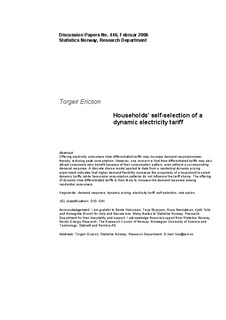| dc.contributor.author | Ericson, Torgeir | |
| dc.date.accessioned | 2011-11-21T13:08:59Z | |
| dc.date.available | 2011-11-21T13:08:59Z | |
| dc.date.issued | 2006 | |
| dc.identifier.uri | http://hdl.handle.net/11250/180267 | |
| dc.description.abstract | Abstract:
Offering electricity consumers time-differentiated tariffs may increase demand responsiveness,
thereby reducing peak consumption. However, one concern is that time-differentiated tariffs may also
attract consumers who benefit because of their consumption pattern, even without a corresponding
demand response. A discrete choice model applied to data from a residential dynamic pricing
experiment indicates that higher demand flexibility increases the propensity of a household to select
dynamic tariffs, while favourable consumption patterns do not influence the tariff choice. The offering
of dynamic time-differentiated tariffs is then likely to increase the demand response among
residential consumers.
Keywords: demand response, dynamic pricing, electricity tariff, self-selection, rate option. | no_NO |
| dc.language.iso | eng | no_NO |
| dc.publisher | Statistics Norway, Research Department | no_NO |
| dc.relation.ispartofseries | Discussion Papers;No. 446 | |
| dc.subject | Electricity tariff | no_NO |
| dc.subject | Dynamic pricing | no_NO |
| dc.subject | Demand response | no_NO |
| dc.subject | Electricity consumption | no_NO |
| dc.subject | Households | no_NO |
| dc.subject | JEL classification: D10 | no_NO |
| dc.subject | JEL classification: Q41 | no_NO |
| dc.title | Households' self-selection of a dynamic electricity tariff | no_NO |
| dc.type | Working paper | no_NO |
| dc.subject.nsi | VDP::Social science: 200::Economics: 210::Economics: 212 | no_NO |
| dc.source.pagenumber | 32 s. | no_NO |
